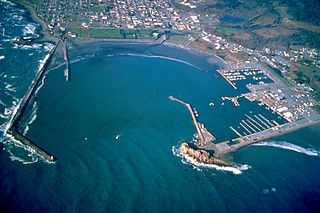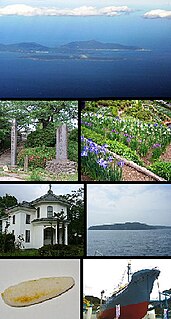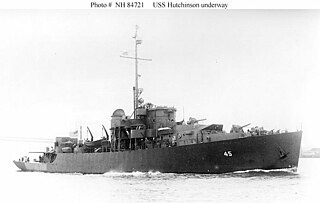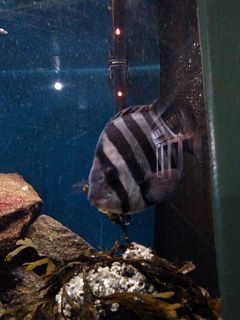
A tsunami or tidal wave,, also known as a seismic sea wave, is a series of waves in a water body caused by the displacement of a large volume of water, generally in an ocean or a large lake. Earthquakes, volcanic eruptions and other underwater explosions above or below water all have the potential to generate a tsunami. Unlike normal ocean waves, which are generated by wind, or tides, which are generated by the gravitational pull of the Moon and the Sun, a tsunami is generated by the displacement of water.

Cabot Strait is a strait in eastern Canada approximately 110 kilometres wide between Cape Ray, Newfoundland and Cape North, Cape Breton Island. It is the widest of the three outlets for the Gulf of Saint Lawrence into the Atlantic Ocean, the others being the Strait of Belle Isle and Strait of Canso. It is named for the Genoese explorer Giovanni Caboto.

Crescent City is the county seat of, and only incorporated city in, Del Norte County, California. Named for the crescent-shaped stretch of sandy beach south of the city, Crescent City had a total population of 7,643 in the 2010 census, up from 4,006 in the 2000 census. The population includes inmates at Pelican Bay State Prison, also within the city limits, and the former census-designated place Crescent City North annexed to the city. The city is also the site of the Redwood National Park headquarters, as well as the historic Battery Point Light. Due to the richness of the local Pacific Ocean waters and the related catch, and ease of access, Crescent City Harbor serves as home port for numerous commercial fishing vessels.

Ishinomaki is a city located in Miyagi Prefecture, Japan. As of 28 February 2017, the city has an estimated population of 146,993, and a population density of 269 persons per km2 in 61,233 households. The total area of the city is 554.58 square kilometres (214.12 sq mi).

Kesennuma is a city in Miyagi Prefecture, Japan. As of 31 May 2017, the city had an estimated population of 65,367 and a population density of 197 inhabitants per square kilometre (510/sq mi) in 26,429 households. The total area of the city is 332.44 square kilometres (128.36 sq mi). Large sections of the city were destroyed by the 2011 Tōhoku earthquake and tsunami and major fires on March 11, 2011.

The Seto Inland Sea, also known as Setouchi or often shortened to Inland Sea, is the body of water separating Honshū, Shikoku, and Kyūshū, three of the four main islands of Japan. The region that includes the Seto Inland Sea and the coastal areas of Honshū, Shikoku, and Kyūshū is known as the Setouchi Region. It serves as a waterway, connecting the Pacific Ocean to the Sea of Japan. It connects to Osaka Bay and provides a sea transport link to industrial centers in the Kansai region, including Osaka and Kobe. Before the construction of the San'yō Main Line, it was the main transportation link between Kansai and Kyūshū.

A river gunboat is a type of gunboat adapted for river operations. River gunboats required shallow draft for river navigation. They would be armed with relatively small caliber cannons, or a mix of cannons and machine guns. If they carried more than one cannon, one might be a howitzer, for shore bombardment. They were usually not armoured. The fictional USS San Pablo described in Richard McKenna's The Sand Pebbles is an example of this class of vessel, serving on the US Navy's Yangtze Patrol. Stronger river warships were river monitors.

USS Hutchinson (PF-45), a Tacoma-class frigate, was the only ship of the United States Navy to be named for Hutchinson, Kansas.
USS LST-84 was one of the hundreds of Tank landing ships built during World War II to support amphibious military operations. Her role was to carry significant quantities of vehicles, cargo, and troops directly onto an unimproved shore. The ship was sponsored by Mrs. W. Raymond Brendel. The ship was constructed inland at Jeffersonville, Indiana, by the Jeffersonville Boat & Machine Co. as coastal ship yards were used to build larger naval vessels. The ship traversed the Ohio and Mississippi River to reach open water.

USS Charles Lawrence (DE-53) was a Buckley-class destroyer escort of the United States Navy, commissioned in 1943. She was converted to a high speed transport in 1944 and redesignated APD-37. After being decommssioned in 1946, she was finally scrapped in 1965.

The Insect-class gunboats were a class of small, but well-armed Royal Navy ships designed for use in shallow rivers or inshore. They were intended for use on the Danube against Austria-Hungary. The first four ships—Gnat, Mantis, Moth and Tarantula—were first employed during the World War I Mesopotamian Campaign on the Euphrates and Tigris rivers.

The first USS Wateree was a sidewheel gunboat in the United States Navy during the American Civil War.
The Sarancha class is the NATO reporting name for a hydrofoil missile boat built for the Soviet Navy. The Soviet designation was Project 1240 Uragan.

The 1797 Sumatra earthquake occurred at 22:00 local time on February 10. It was the first in a series of great earthquakes that ruptured part of the Sumatran segment of the Sunda megathrust. It caused a damaging tsunami that was particularly severe near Padang, where a 150–200 ton English ship was driven 1 km inland up the Arau River.

The No.1 class auxiliary patrol boat was a class of patrol boat of the Imperial Japanese Navy (IJN), serving during World War II. 280 vessels were planned under the Maru Sen Programme, however, only 27 vessels were completed before the end of the war.

PLTD Apung 1 is an electric generator ship in Banda Aceh, Sumatra, Indonesia that has become a tourist attraction. The 2,600-ton vessel had been in the sea and was flung 2 to 3 kilometres inland by the 2004 Indian Ocean earthquake and tsunami. It was owned by PLN, the local power generating company, and crashed upon two homes when it landed, killing those inside. Visitors are able to enter the ship, and can explore the interior in its entirety.

Ryou-Un Maru was a Japanese fishing boat that was washed away from its mooring in Aomori Prefecture by the March 2011 Tōhoku earthquake and tsunami and drifted across the Pacific Ocean. It was spotted a year later by a routine Royal Canadian Air Force air patrol about 150 nautical miles off the coast of Haida Gwaii, British Columbia. The unmanned hulk entered U.S. waters on 1 April 2012, and, after salvage attempts failed, was sunk by the U.S. Coast Guard on 5 April 2012 to prevent the hulk from becoming a hazard to navigation.

The tsunami fish is the surviving specimen of five striped beakfish that lived for more than two years in the partially submerged hull of the Japanese boat Sai-shou-maru (斎勝丸), after the boat broke loose and went adrift during the 2011 Tōhoku earthquake and tsunami. On March 22, 2013, the boat washed onshore in North America at Long Beach, Washington, more than 4,000 miles (6,400 km) from its starting point. The fish now lives in the Seaside Aquarium in Seaside, Oregon.

The Japanese submarine I-53, later I-153, was a Kaidai-class cruiser submarine of the KD3A sub-class built for the Imperial Japanese Navy (IJN) during the 1920s. She supported Japanese forces during the invasion of Malaya in December 1941 and the Dutch East Indies campaign in early 1942.


















